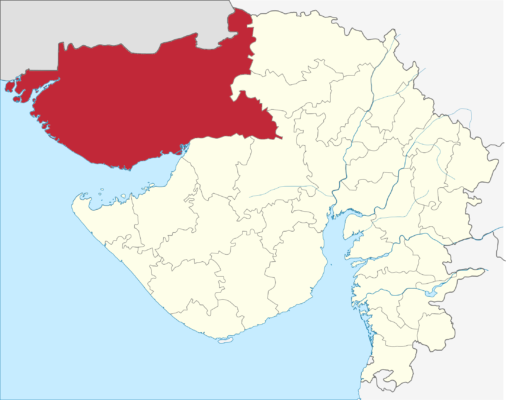The Kutch Mahotsav
The Kutch Mahotsav aptly called the ‘Mahotsav’ (great festival) is a guided tour of the life and times of Kutch, its beauty, nostalgia, ethos, traditions, culture and spirit. Kutch Mahotsav is usually organized during February and March each year. The festival organized by the Tourism Corporation of Gujarat, is a six-day tour into the heartlands of Kutch. The tour includes a visit to Bhuj at the heart of Kutch, Mata no Madh, an old temple dedicated to the mother goddess believed to be 1200 years old. Lakhpat, a deserted port transports you to a time when it was once the hub of Gujarat’s flourishing sea trade. The Mahotsav also takes you to Narayan Sarovar, one of the most sacred pilgrimage sites for orthodox Hindus, Koteshwar and Bhadreshwar, also important pilgrimage centres along the Mahotsav circuit. Anjar, the beaches of Mandvi, Dhola Vira’s archaeological ruins and the rural fair at Dhrang completes a rich insight into Kutch, its colourful people, historic towns and remarkable handicrafts.
Fair of “Mota Yaksh”
Fair of “mota yaksh” (at kakdbhit, bhadrapad sud, 15— sept) This is the largest fare in kutch. 40kms. Far from bhuj, this festival lasts for three days.Its a legend that “yakshas(angels!!)” came here to save the people from cruel rural, and taught them some skills to improvise their life style. Since then people are celebrating this fare near the temple built in their memory. This place is also known as mini ” taranetar ” (largest fair of gujarat)”.
Fair of Hajipir
Fair of “Hajipir” (at hajipir(banni), 1st monday of april(chaitra).) This fare is celebrating in the memory of a holy saint “haajipir”. This fare represents the true non-secularism of the kutch. Saint “haajipir” was muslim, but this place is as holy for “hindus ” as it is for “muslims”. He spent his days in the service of people. He died in an attempt to save cows from bandits. He is also known as “zinda (alive) pir”. His place is also known as “haajipir” and it is 100 kms. Far from “bhuj”.
Dada Mekan Fair
Dada Mekan” Fair (at “dhrang”, 30 kms. far from bhuj) On very holy festival of lord “shiva”,”mahashivratri”, this fare is celebrated for remembrance of the great saint “dada mekan”. He has spent his whole life in desert to help any one lost in the great rann of kutch, with the help of their great partners a dog and a donkey. Gujarat tourism organizes the “kutch festival” during this fare. This fare is also famous its glory of rural tradition and “malakhdo (wrestling)” and “renkda dod (cart racing )”
Fair of Shitla Saptami
Shitla Saptami Fair (“saatam-aatham”) On the occasion of the birthday of lord “krishna”, this fare is celebrated by warm hearted people at “hamirsar lake”, bhuj. Its a two days festival, first day is celebrated as “shitla saptami” or “saatam”and another day is celebrated as “janmashtami” or “aatham”. On the second day processions for breaking the “mataki (pot)” hanging overhead with milk products and some money. This is done in remembrance of early days of lord “krishna”, when he was at “gokul”.
Fair of “Jesal-Toral”
Fair of “Jesal-Toral” (at anjar, on shravan vad 7th & 8th August.) This fare is celebrated in the memory of saintly couple “jesal” and “toral”. Jesal was famous bandit of kutch, and toral was a holy princess. The company of toral changed the jesal and he became the saint. Together they served the people in kutch. This fare is held at “anjar” 45 kms. From “bhuj”, this fare is also one of the most famous and worth watching.
Bhujia fair or “Naagpanchmi”
Bhujia fair or “naagpanchmi” (shravan sud 5, august) At the foot of the hill “bhujia”, bhuj, this fare is celebrated to pray “naag dev (snake god)” . The temple of “naag dev” is located at the top of “bhujia” hill”. As this land is depending on agriculture, the snacks are serving the purpose of keeping insects and mice away from crop, indians are paying the snacks back by worshiping them.

 Kachchh is an ancient land with an important historical age. The name Kachchh was derived from its geographical characteristics and particularly resemblance of its earth surface with tortoise. Ancient literature mentioned this name. Mallinath, the 19th Jain Tirthankar, in his treatise of Sanjivani, defined Kachchh as during ancient time marshland or fallow land. The foreign travellers who visited the region had mentioned in various records about the name Kachchh. It was also mentioned in rock inscriptions, copper plate inscriptions, ancient writings and manuscripts.
Kachchh is an ancient land with an important historical age. The name Kachchh was derived from its geographical characteristics and particularly resemblance of its earth surface with tortoise. Ancient literature mentioned this name. Mallinath, the 19th Jain Tirthankar, in his treatise of Sanjivani, defined Kachchh as during ancient time marshland or fallow land. The foreign travellers who visited the region had mentioned in various records about the name Kachchh. It was also mentioned in rock inscriptions, copper plate inscriptions, ancient writings and manuscripts.